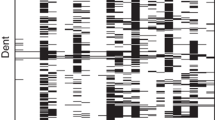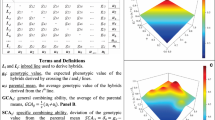Abstract
In hybrid breeding, the prediction of hybrid performance (HP) is extremely important as it is difficult to evaluate inbred lines in numerous cross combinations. Recent developments such as doubled haploid production and molecular marker technologies have enhanced the prospects of marker-based HP prediction to accelerate the breeding process. Our objectives were to (1) predict HP using a combined analysis of hybrids and parental lines from a breeding program, (2) evaluate the use of molecular markers in addition to phenotypic and pedigree data, (3) evaluate the combination of line per se data with marker-based estimates, (4) study the effect of the number of tested parents, and (5) assess the advantage of haplotype blocks. An unbalanced dataset of 400 hybrids from 9 factorial crosses tested in different experiments and data of 79 inbred parents were subjected to combined analyses with a mixed linear model. Marker data of the inbreds were obtained with 20 AFLP primer–enzyme combinations. Cross-validation was used to assess the performance prediction of hybrids of which no or only one parental line was testcross evaluated. For HP prediction, the highest proportion of explained variance (R 2), 46% for grain yield (GY) and 70% for grain dry matter content (GDMC), was obtained from line per se best linear unbiased prediction (BLUP) estimates plus marker effects associated with mid-parent heterosis (TEAM-LM). Our study demonstrated that HP was efficiently predicted using molecular markers even for GY when testcross data of both parents are not available. This can help in improving greatly the efficiency of commercial hybrid breeding programs.



Similar content being viewed by others
References
Balding DJ (2006) A tutorial on statistical methods for population association studies. Nat Rev Genet 7:781–791
Bernardo R (1994) Prediction of maize single-cross performance using RFLPs and information from related hybrids. Crop Sci 34:20–25
Bernardo R (1998) Predicting the performance of untested single crosses: trait and marker data. In: Lamkey KR, Staub JE (eds) Concepts and breeding of heterosis in crop plants. Crop Science Society of America, Madison, pp 117–127
Bernardo R (1999) Marker-assisted best linear unbiased prediction of single-cross performance. Crop Sci 39:1277–1282
Bernardo R (2002) Breeding for quantitative traits in plants. Stemma Press, Woodbury
Bernardo R, Murigneux A, Karaman Z (1996) Marker-based estimates of identity by descent and alikeness in state among maize inbreds. Theor Appl Genet 93:262–267
Charcosset A, Bonnisseau B, Touchebeuf O, Burstin J, Dubreuil P, Barriere Y, Gallais A, Denis JB (1998) Prediction of maize hybrid silage performance using marker data: comparison of several models for specific combining ability. Crop Sci 38:38–44
Dudley JW (1993) Molecular markers in plant improvement: manipulation of genes affecting quantitative traits. Crop Sci 33:660–668
Eathington SR, Crosbie TM, Edwards MD, Reiter RS, Bull JK (2007) Molecular markers in a commercial breeding program. Crop Sci 47:S154–S163
Falconer DS, Mackay TF (1996) Introduction to quantitative genetics. Longman Group, Essex
Fischer S, Möhring J, Schön CC, Piepho H-P, Klein D, Schipprack W, Utz HF, Melchinger AE, Reif JC (2008) Trends in genetic variance components during 30 years of hybrid maize breeding at the University of Hohenheim. Plant Breed 127:446–451
Gardner CO, Eberhart SA (1966) Analysis and interpretation of the variety cross diallel and related populations. Biometrics 22:439–452
Gilmour AR, Cullis BR, Welham SJ, Thompson R (2002) ASReml reference manual. Release 1.0. VSN International, Hemel Hempstead
Hallauer AR (1990) Methods used in developing maize inbreds. Maydica 35:1–16
Hallauer AR, Miranda Filho JB (1988) Quantitative genetics in maize breeding. Iowa State University Press, Ames
Longin CFH, Utz H, Melchinger A, Reif JC (2007) Hybrid maize breeding with doubled haploids. II. Optimum type and number of testers in two-stage selection for general combining ability. Theor Appl Genet 114:393–402
Melchinger AE, Messmer MM, Lee M, Woodman WL, Lamkey KR (1991) Diversity and relationships among U.S. maize inbreds revealed by restriction fragment length polymorphisms. Crop Sci 31:669–678
Parisseaux B, Bernardo R (2004) In silico mapping of quantitative trait loci in maize. Theor Appl Genet 109:508–514
SAS Institute Inc. (2000) SAS System 8. SAS Institute Inc., Cary
Schmidt W (2004) Hybridmaiszüchtung bei der KWS SAAT AG. Bericht über die 54. Tagung der Vereinigung der Pflanzenzüchter und Saatgutkaufleute Österreichs 2003, Gumpenstein, pp 1–6 (in German)
Schrag TA, Melchinger AE, Sørensen AP, Frisch M (2006) Prediction of single-cross hybrid performance for grain yield and grain dry matter content in maize using AFLP markers associated with QTL. Theor Appl Genet 113:1037–1047
Schrag TA, Maurer HP, Melchinger AE, Piepho H-P, Peleman J, Frisch M (2007) Prediction of single-cross hybrid performance in maize using haplotype blocks associated with QTL for grain yield. Theor Appl Genet 114:1345–1355
Schwarz G (1978) Estimating the dimension of a model. Ann Stat 6:461–464
Seitz G (2005) The use of doubled haploids in corn breeding. In: Proceedings of the 41st annual Illinois corn Breeders’ School 2005, Urbana-Champaign, pp 1–7
Smith OS (1986) Covariance between line per se and testcross performance. Crop Sci 26:540–543
Tukey JW (1977) Exploratory data analysis. Addison-Wesley, Reading
Vos P, Hogers R, Bleeker M, Reijans M, Van de Lee T, Hornes M, Frijters A, Pot J, Peleman J, Kuiper M, Zabeau M (1995) AFLP—a new technique for DNA-fingerprinting. Nucleic Acids Res 23:4407–4414
Vuylsteke M, Mank R, Antonise R, Bastiaans E, Senior ML, Stuber CW, Melchinger AE, Lübberstedt T, Xia XC, Stam P, Zabeau M, Kuiper M (1999) Two high-density AFLP® linkage maps of Zea mays L.: analysis of distribution of AFLP markers. Theor Appl Genet 99:921–935
Vuylsteke M, Kuiper M, Stam P (2000) Chromosomal regions involved in hybrid performance and heterosis: their AFLP®-based identification and practical use in prediction models. Heredity 85:208–218
Acknowledgments
This project was supported by the German Research Foundation DFG in the framework program ‘Heterosis in Plants’ (research grants FR 1615/3-1 and 3-3). The staff at the Plant Breeding Research Station at Eckartsweier and Hohenheim is gratefully acknowledged for conducting the field experiments. The authors appreciate the editorial work of J. Muminović and thank H.F. Utz for his valuable comments and suggestions.
Author information
Authors and Affiliations
Corresponding author
Additional information
Communicated by H. C. Becker.
Rights and permissions
About this article
Cite this article
Schrag, T.A., Möhring, J., Maurer, H.P. et al. Molecular marker-based prediction of hybrid performance in maize using unbalanced data from multiple experiments with factorial crosses. Theor Appl Genet 118, 741–751 (2009). https://doi.org/10.1007/s00122-008-0934-9
Received:
Accepted:
Published:
Issue Date:
DOI: https://doi.org/10.1007/s00122-008-0934-9




